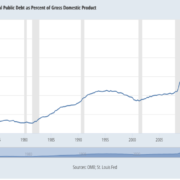You don?t have to wait until May for the next correction in the stock market, which is only four trading days away. Take a look at the charts below prepared by my good friends, Arthur Hill and John Murphy at Stockcharts.com, and you?ll see it has already started. In fact, it might be almost over.
Only 42% of stocks listed on the New York Stock Exchange are now above their 50-day moving averages, down from the 90% peak at the end of January. That suggests we are already well into bear market territory. The downturn has been lead by materials, technology, energy, and industrials.
Look at the charts for the S&P 500 (SPY) and the Dow. We are clearly on target to match the previous all time highs in the next few days, possibly during the month end liquidity surge. That?s where potential double tops come into play. If I am right, then we could be in for a 5%-10% pullback. If I am wrong, then we are in for a flat line for a month before we resume the upward path.
So I am modifying my trading strategy that has been wildly successful for the past six months, delivering to you a 45% performance gain off the bottom. To use all of my favorite sailing metaphors, I?ll be battening down the hatches, clearing the decks, reefing the sheets, and preparing for a squall.
Here are the following course adjustments I recommend for a tougher market:
1) Cut your book in half and maintain a 50% cash position to take advantage of the unanticipated opportunities that will almost certainly come. You can?t buy bottoms if you lost all of your money on the downslide.
2) Shorten your maturities. Instead of betting the ranch by going out two or three months, limit option positions to the front month. There is no crueler existence than managing a long dated option position that is going against you.
3) Pigs get fed, but hogs get slaughtered. Instead of running positions into expiration, go for quicker, smaller profits. Instead of keeping the entire profit, settle for half or two thirds. Market volatility is so low that it is not worth hanging on for the final two weeks just to capture the last few basis points. This shortens the time that surprises or black swans can happen. Use time as capital. As I have so magnificently shown this year, you get a much higher score hitting 40 singles than a couple of home runs (hint for foreigners: our baseball season has just started).
4) Get yourself some short exposure for the inevitable shakeout. I recommend put spreads in the Russell 2000 (IWM), which always falls the fastest in down markets. But go at least 5% in-the-money to give yourself a safety margin income in case this thing keeps clawing its way up.
5) Avoid positions that have worked well for the past half-year, because this is where traders will rush to take profits and ?de-risk? their books first. This includes long positions in consumer staples, pharmaceuticals, utilities, and transportation, and short positions in commodities (CU), oil (USO), and precious metals (GLD) (SLV).
6) Get out of your bond shorts. It?s amazing to me that ten-year yields (TLT) have fallen to a parsimonious 1.70%, while stocks have rallied. But then, it has been an amazing life. This is rare in the rich tapestry of financial markets and usually presages trouble. It can only mean that the smart money is positioning itself cautiously in anticipation of a dump in stocks. If that is the case, the May correction could take ten year yields down to 1.50%, and bond prices though the roof. Use the month end ?RISK ON? surge to take profits on the (TBT).
There is an alternative explanation for all of this. The correction is already done and we are about to launch into a new bull leg. The selloff has been masked by a rotation within the broader indexes. Take another look at the chart of stocks above their 50-day moving averages. We have spent three months falling from 90% to 42%. Historically, it bottoms at 20%. The last time this happened was at the end of November and early June. Remember what happened after that?
If that is the case, we are already two thirds of the way through the spring correction, and on the eve of another 5%-10% leg up in stocks and other risk assets. It is what investors are least expecting; therefore, it cannot be ruled out. As my in-house strategist, Sherlock Holmes, used to say, ?Eliminate the obvious, and consider all other possibilities.?











